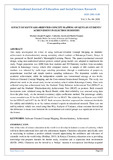| dc.contributor.author | Wangila, Joseph M. | |
| dc.contributor.author | Aurah, C. | |
| dc.contributor.author | Wanjala, M. | |
| dc.date.accessioned | 2022-05-09T10:13:25Z | |
| dc.date.available | 2022-05-09T10:13:25Z | |
| dc.date.issued | 2020-01 | |
| dc.identifier.citation | International Journal of Education and Social Science Research ISSN 2581-5148 Vol. 3, No. 04; 2020 | en_US |
| dc.identifier.issn | 2581-5148 | |
| dc.identifier.uri | https://www.researchgate.net/publication/343767310_EFFECT_OF_SOFTWARE-ORIENTED_CONCEPT_MAPPING_ON_KENYAN_STUDENTS'_ACHIEVEMENT_IN_ELECTROCHEMISTRY | |
| dc.identifier.uri | https://ir-library.mmust.ac.ke/xmlui/handle/123456789/1863?show=full | |
| dc.identifier.uri | http://hdl.handle.net/123456789/5799 | |
| dc.description.abstract | This study investigated the effect of using Software-Oriented Concept Mapping on students’ achievement in electrochemistry among secondary school students in Kakamega County, Kenya. It was grounded on David Ausubel’s Meaningful Learning Theory. The quasi-experimental research design, using non-randomized pretest-posttest control group model, was adopted to implement the study. Target population was 4,000 form four students and 30 Chemistry teachers from secondary schools in Kakamega County, which offer computer studies. A sample of 400 students and 10 teachers was selected by multi-stage sampling procedure, through a combination of purposive, proportionate stratified and simple random sampling techniques. The dependent variable was academic achievement, while the independent variable was instructional strategy at two levels; Software-Oriented Concept Mapping and the Conventional Instructional Strategies. The study was piloted one week to the actual study in one secondary school within Kakamega County. Data were collected using two achievement tests, the Students’ Entry Behavior Achievement Test (SEBAT) as pretest and the Students’ Electrochemistry Achievement Test (SEAT) as posttest. Both research instruments were validated using the Rasch Model, while their reliability was assessed using data from the pilot study, via the internal consistency alpha coefficients method. The percentage validity scores awarded were 85 for the SEBAT and 81 for the SEAT. The reliability coefficients were 0.805 for the SEBAT and 0.877 for the SEAT. Both measures therefore surpassed the minimum thresholds for validity and reliability as set by various research experts in educational research. There was one null hypothesis, which was tested using One-Way Analysis of Variance, whose outcome showed that the difference in mean score between the experimental and control groups was significant in favor of the former. | en_US |
| dc.language.iso | en | en_US |
| dc.subject | Software Oriented Concept Mapping, Electrochemistry, Achievement | en_US |
| dc.title | Effect of Software-Oriented Concept Mapping on Kenyan Students’ Achievement in Electrochemistry | en_US |
| dc.type | Article | en_US |

